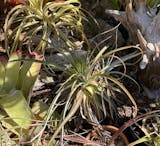Hechtia 'Dorothy'
4837
A rare hybrid of Hechtia argentea x tillandsioides named after Dorothy Byer. It Is not clear if this is a natural hybrid or a man-made hybrid, but was named by Dorothy along with Dutch Vandervort.
Hechtia hybrids are very rarely made as it takes a male and female plant, blooming at the same time, not just two different plants. A large grower with very many narrow, tapering leaves in a full, leafy rosette. The leaves arch gracefully, somewhat recurving. The marginal spines are very reduced, but are sharp and the plant should be handled with caution as the leaf edges can cut your skin quite easily.




Hechtia 'Lynn'
8972
A large growing terrestrial to 24 inches across, that has abundant silver 'fuzzy' trichomes on both sides of the leaves. When stressed is blushes purple. This usually happens in winter.






Hechtia 'Ventura'
3351
A cultivar of the hybrid marnier-lapostollei x glomerata by Sally Marz. Hechtia hybrids are fairly unusual. This plant, according to the late Dutch Vandeervort is a "A robust version of marnier-lapostollei" - leaves to about 12 inches and was a favorite of his with many gracing his Ventura, California garden. Many narrow, somewhat soft, spiny green leaves dusted with silver. A handsome plant and easy to grow.






Hechtia epigyna
5608
A species from Tamaulipas state of Mexico. An easy to grow species that forms large, silvery-scurfy rosettes. Oddly, the offsets come off with soft, glabrous leaves, developing the scurfy appearance that protects them from the sun, as they mature. The narrow, spiny leaves are rather soft (for a Hechtia) and the tips naturally die back and curl.






Hechtia lanata x myriantha
9309
Both parents of this Ray Lemieux cross of Hechtia lanata x myriantha have some interesting characteristics that should express themselves when the plants grow out. The seed parent, H. lanata, has broad, scurfy, twisting and curling leaves in habitat, which is a tropical desert environment on nutrient poor cliffs.
In cultivation, seedlings of this species tend to have straighter foliage, at least here in sea-level Florida. The pollen parent, H. myriantha, is a giant grower, perhaps the largest of all Hechtia species. Anecdotal stories report that this plant can reach the size of a VW Beetle! The intent of this cross was to produce a large growing hybrid with twisted foliage and silvery scurf. Only time will tell if that will happen.
*SALE - SPECIAL REDUCED PRICE
**Plants are ready for an 8 or 10-inch Pot

Great cross. I got this specimen in July, 2021 and set it in a wide pot. So far it’s more than tripled in size and is beginning to overflow the edges of the pot (as in this picture from this past January). It’s been in full sun and doing well - the color does change here with the season (ranging from more red to more green as the angle of the sun changes), but that seems to be typical for several of my Hechtia specimens. Definitely recommend.
Hechtia lepidophylla Queretaro, Mexico
6797
A widespread species that is found in many habitats from south Texas to Guatemala. This one has narrow green leaves with small sharp spines. The foliage is covered with white trichomes on the underside of the leaves. There is a noticeable leaf imprint on the underside of the leaf. We have not seen it bloom yet. This clone comes from Queretaro, Mexico, and was collected by Andy Siekkenen and carries his accession number: AS047.








Hechtia marnier-lapostollei
8159
A very fine smaller species with thickly succulent, very silvery to almost fuzzy leaves. Native to Southwestern Mexico, this clone is one from the collection of Ruby Ryde in Australia. A very nice, compact clone with very thick, silvery-white leaves. This species is easy to grow, will mature in a 6 inch pot but would do best in a larger container as the plant will form a cluster with time. The inflorescence is pink to purplish and plants are either male or female.




Hechtia rosea x caerulea
1970
This Tropiflora hybrid definitely came out looking more like the H. coerulea parent, with semi-stiff, green, grassy leaves. The leaf margins, although 'spineless', are very sharp and can give a swift ’paper cut’ to the unwary. For something unusual, give one a try!






Hechtia rosea x marnier-lapostollei
6321
A Tropiflora hybrid with our best red rosea (formerly meziana). These are running the gamut from silver to red, some with scurfing, some without, all nice.




Hechtia species SEL1994-0270 Edo. Queretaro, Mex.
8782
A silver plant that we acquired from Selby Gardens as Hechtia argentia. After the plant bloomed for us bloom for us it was obvious that it is not Hechtia argentia. This plant takes on an odd light-blue cast in full sun. The mother plant of this was 25 inches across.










Plant outstanding as usual! But the packaging was beyond belief! Must have taken an hour to get all the styrofoam peanuts in without damaging one leaf! Outstanding thanks to your crew for their excellent work and service!
Very nice little plant. Many thanks!
x Putia 'Gecko'
2121
A spineless Puya laxa hybrid from Bryan Windham. It has light green recurving leaves with white scurf. A medium size growing plant. Does best in high light.








